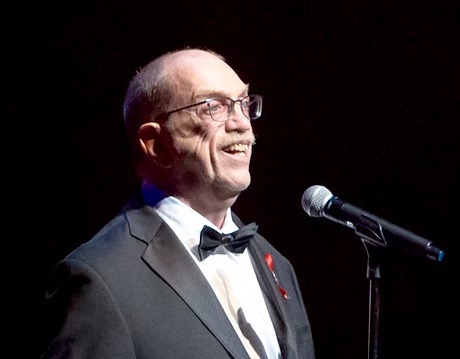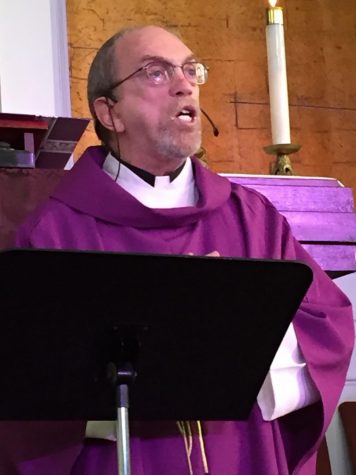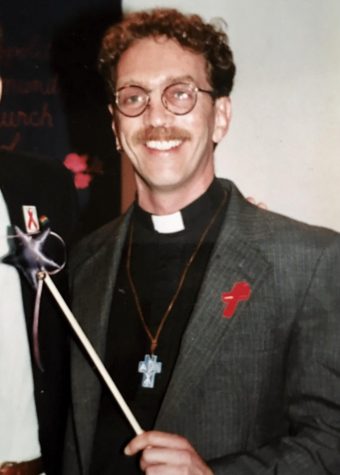AIDS survivor and activist preaches against prejudice
October 27, 2021
People acted too afraid to touch him or be in the same room with him. Fighting for his voice to be heard was a challenge Steve Pieters began facing when he was diagnosed with acquired immunodeficiency syndrome (AIDS).
AIDS. An epidemic that swept the nation during the 1980s to 90s, with approximately 700,000 people in the U.S. dying from AIDS and HIV-related illness, according to a study done by the Kaiser Family Foundation (KFF).
AIDS is the late stage of human immunodeficiency virus (HIV) infection that occurs when the body’s immune system is badly damaged because of the virus. HIV is a virus that attacks cells that help the body fight infection, making a person more vulnerable to other infections and diseases, according to HIV.gov.
People diagnosed with AIDS face prejudice, and even in the medical world, many doctors refuse to make direct contact with them. Despite being a sexually transmitted disease, a stigma has been created around AIDS.
“It’s transmitted sexually. The physicians knew this, and yet there was a great deal of prejudice against individuals who were HIV infected. It was not unusual for physicians to walk into the doctor’s office, wearing full contagion garb, that may be very much indicated in a disease like COVID that is spread in the air,” Alexandra Levine, an AIDS and cancer doctor, said.
Pieters was diagnosed with AIDS in 1982 before AIDS became very widespread and well known. Being one of the first to be diagnosed with AIDS was very scary for Pieters, yet he realized it gave him the opportunity to spread awareness about AIDS.
“It was a really frightening time, and I thought right away that it would do the world good if I put a human face on AIDS. So I came out and did media interviews about AIDS, early on in the early 80s, and it was a scary time because people didn’t even want to be in the same room with me,” Pieters said.

Being a gay activist throughout the 70s, Pieters was used to putting himself out there and advocating for gay rights. So when he was diagnosed with AIDS, Pieters knew he had to take action in some way.
“I was accustomed to putting a human face on being gay in the media, and there was so little known about AIDS. I knew that if you could see what a person with AIDS looked like, it might change your mind about how you feel about people with AIDS,” Pieters said.
Pieters hoped to advocate against the prejudice of having AIDS and being gay as, during that time, AIDS patients were being treated unjustly. It was not uncommon even to refuse to merely touch someone with AIDS. Levine talks about her experience in seeing the hardships AIDS patients and physicians had to endure.
“The patients were surrounded, and the physicians were surrounded with a lot of hate and distrust, and ugliness in every single way. It was common practice for physicians to refuse to take care of AIDS patients,” Levine said.
Pieters didn’t stop advocating when he saw this injustice, but rather he was fueled to take action. He started to work for justice issues for people with AIDS. Pieters became a huge advocate for the Americans with Disabilities Act (ADA). According to the official website of the ADA, the act is known as the act resembling the Civil Rights Act of 1964. It states that people with disabilities should have an equal opportunity under the law. Pieters saw the ADA as an opportunity for people with AIDS rights to be protected.
“There was a lot of discrimination against us, and there were no laws really protecting us. The Americans with Disabilities Act grew out of people with AIDS demonstrating for our rights as human beings to accommodation. We didn’t have any laws protecting our housing or employment or anything, so that eventually went into action that created the Americans with Disabilities Act,” Pieters said.
Pieters sees his want to take action as being deeply rooted in personal beliefs. One of these beliefs is the idea that helplessness leads to hopelessness. He believes that action must be taken to create hope.
Pieters says a large part of what helped him survive AIDS was that he took action. He believes in the power of action and what it can bring to someone and others.
“If you want to create hope, you need to take action. Action equals life; silence equals death. So it was important for me to take action if I wanted to survive,” Pieters said.
Besides taking action as an activist, Pieters was also a gay pastor. He is currently a retired minister with the Metropolitan Community churches today. Pieters accounts a lot of the hope that he had while he had AIDS to his faith.

“Looking at what it meant to believe in the resurrection of Jesus Christ led me to preach and teach and believe that if God is greater than the death of Jesus on the cross, then God is greater than AIDS. Even if they told me the worst thing they could possibly tell me, I could still fully live. I could still laugh, I could still sing, I could still enjoy my friends, and I could still dance. It was a life-changing moment for me to really look at what it meant to believe in God’s healing power,” Pieters said.
Pieter’s faith gave him hope and a will to fight. Finding those pathways to hope and peace was largely stressed by Levine, Pieter’s doctor when he had AIDS, as a key practice to combatting illnesses such as AIDS, especially when medicine is not available.
“So I will say to a patient. At a certain point, what gives you peace? What relaxes your soul? There are all kinds of things they can do. Going to church, going to a psychologist, exercising, and in my own example, going to the beach and listening to the sound of the waves relaxes my soul. What relaxes your soul? Those were the kinds of things that I said to Steve, and those were the things that he went forward in his own way to try to accomplish,” Levine said.
Pieters also says simple things such as exercising at the gym, studying nutrition, eating well, taking vitamins and minerals, and laughter therapy gave him hope.
Levine also emphasizes that practices such as the ones above were helpful as they could create peace and hope. Levine stresses peace and hope being a fundamental part of strengthening the immune system and recovery.
“It turns out that all of the chemicals related to stress and depression, loneliness, and anxiety weaken your immune system. My hypothesis always has been, that if in fact, those stresses can weaken the immune system, perhaps, allowing the patient to achieve a sense of peace and being comfortable, as opposed to scared to death, may allow the immune system to get stronger,” Levine said.
When Pieters was diagnosed, he was also facing two-terminal forms of cancer and told he had eight months to live. Despite these extreme challenges, Pieters says maintaining hope helped him keep fighting.
“It looked like everybody was going to die from AIDS. My doctor said, not everybody will, and if one of the millions survives, why not believe that you’re going to be that one in a million, and act accordingly,” Pieters said.
Levine points out that there was no medicine at the beginning of the AIDS epidemic, and a lot of the healing was done through the mind.
“I had no medicines when this epidemic began. It didn’t even have a name, let alone a treatment. On the other hand, we have had healer shaman medicine throughout all of the history of mankind. The bottom line is if those individuals had no medicines of any sort whatsoever and they were called back to the home century after century, meant to me that they had to have been doing something,” Levine said.
Eventually, Pieters was put on a drug trial that led to both of his cancers going into complete remission and marked a turning point for his health.
Pieters is very thankful for all those who helped him while he was recovering from AIDS. He is also very thankful for the experiences he was able to endure. He says one of his most memorable moments was attending a prayer breakfast at the White House.
“What an extraordinary opportunity to speak truth to power. Literally, to be able to sit there and talk with Bill Clinton over breakfast about the issues closest to my heart, AIDS, and maintaining hope in the face of AIDS. I encouraged him to use his bully pulpit of the White House to increase the visibility of people with AIDS and to increase the knowledge that people need to have about safe sex to prevent further infection with HIV and AIDS,” Pieters said.

Pieters also was very grateful for the opportunity to have his work included in the Smithsonian, especially his fairy wand, which he would carry with him whenever he spoke anywhere in the world about what it was like to live with AIDS.
“The fairy wand represented to me what Peter Pan teaches us in the story, that fairies die when people don’t believe in them. Well, there were a lot of good fairies that died in the 80s and 90s, and I reminded people to believe in fairies, to believe in ourselves, to believe in each other enough to do the work of healing, whether it be healing into life, or healing into death,” Pieters said.
Pieters also states that one of his most memorable experiences was his 1985 interview with Tammy Faye Baker. Baker was the first televangelist to interview a gay man with AIDS. Pieters said that the interview rocked the conservative Christian movement and changed his and Baker’s lives.
Pieters also feels honored that the 2021 motion picture “In the Eyes of Tammy Faye” will feature a recreation of his interview.
He hopes people will take away from his life experiences in a positive way. Hopefully, hearing his story will empower people to take action in their fight for social justice. Pieters also emphasizes the importance of youth in social justice issues.
He encourages people to find something they are passionate about and take action to pursue it.
“If there’s an issue that’s close to your heart, become active in pursuing that issue. Don’t be afraid to pursue it and become active in that movement. All any of us have is right now, and the important thing now is to be active. I would tell the younger generation you never know what you can face until you’re confronted with it,” Pieters said.
Pieters recognizes that activism is hard and that it takes strength to take action. He encourages others to find their strength within. Pieters emphasizes that courage is an essential factor in pursuing activism as well.
“Be brave. Be courageous. Remember that courage is just fear with heat. You know, sometimes when you’re really scared, you find out that courage is acting on it anyway. So keep going ahead and being brave and doing what is called for. Activism is life. And I think that if you are involved in justice issues now, that will do you well throughout your life,” Pieters said.
Pieters also wants to recognize how tough it is to grow up LGBTQIA+, and he encourages LGBTQIA+ youth to have hope as the world is a lot friendlier place. Also, to know that there are people out there that will accept you.
“It’s still tough to grow up LGBTQ. But things have changed a lot since I was your age. I mean, back when I was your age, there were no public figures who were openly LGBTQ. There was no literature and TV shows or anything that showed us. So, I would tell LGBTQ youth to be happy and grateful that the world has changed so much and that there is marriage equality now. And there is hope. So, when you grow older and come out. If you’re not out already. There will be a wonderful life waiting for you. Don’t be afraid to come out when it’s safe for you to come out. It’s really nice out here in the world,” Pieters said.
Pieters admits that he would tell his younger self that it gets better and that although his life will not be easy, he will find the strength to embrace these challenges.
“I would say to myself. You’re going to come out and be proud of being gay, and you won’t have to feel that shame you used to feel about being gay. I would tell myself that I was going to face a lot of challenges in life, and I wouldn’t be able to face those challenges without the friends that all enabled me to face some of the hardest challenges that a person has to face in life. And so, I would tell my younger self, don’t worry, you’re going to get strong and happy, and you’re going to have a lot of joy. As you move through life, even with all the challenges,” Pieters said.
He accounts much of his joy and strength to his friends who supported him throughout his life. He emphasizes maintaining friendships because friends are the people who know each other best and that will be there for each other. Pieters wants people to know that friends and family are the most important thing in everyone’s life.
“It is really important for you all to nurture your friendships and your family relationships. I’ve been close to death, and I realized that the most important thing in life is to love each other, to look in each other’s eyes, and really see each other for the people that we are and love each other just as we are,” Pieters said.
After being diagnosed and beating AIDS, Pieters, along with his advocacy work and experiences, wants people to take away that it is important to cherish every moment and live their lives to the fullest.
“I learned a Native American saying that goes like this. The quality of life is not measured by the length of life but by the fullness. With which we enter into each present moment here. Now, none of us have any guarantees about being here tomorrow. All any of us have is this moment. This moment to feel fully alive, feel the joy, feel the joy of love and living, and love your family, (and) love your friends. Because, you know, that’s all we have. So be here now. Be fully alive,” Pieters said.
This story was originally published on Scot Scoop News on October 25, 2021.



































